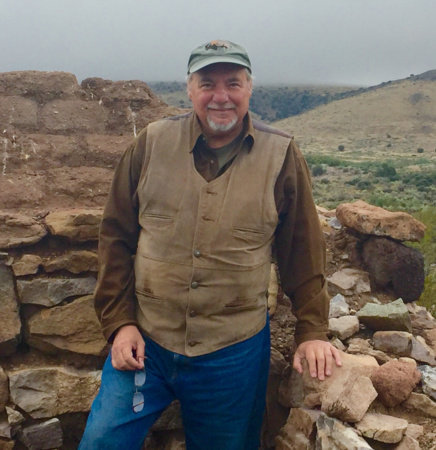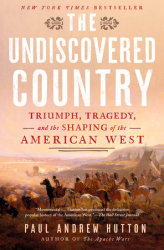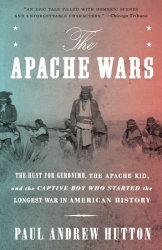For the last few decades, Paul Andrew Hutton has written extensively about the history of the American West, including editing The Custer Reader, a collection of nonfiction works about (and by) George Armstrong Custer, and Phil Sheridan and His Army, a book about the Civil War General who would later play a role in the government’s policies out West.
His latest book, The Apache Wars, covers an extensive temporal and geographic region, and explores the ways in which the Apaches and the U.S. and Mexican governments came into conflict repeatedly in the second half of the nineteenth century.
We spoke with Hutton to learn more about how this book came about, how historical perceptions of these events have changed over time, and the ways in which these conflicts and their aftermath still play a part in contemporary politics.
PENGUIN RANDOM HOUSE:When did you first realize that this was a period of history, and a series of historical events, that you wanted to write about?
PAUL ANDREW HUTTON: It actually goes back to when I was a kid. I grew up in the ’50s, which was the great age of Western movies and TV. My mother got me a children’s book on Cochise back when I was in the sixth grade. It was by Oliver La Farge, who was a Pulitzer Prize-winning author about Indian issues. That was the book. That book hooked me. And that book led me to the old movie “Broken Arrow,” with Jimmy Stewart and Jeff Chandler, which was about the friendship between Cochise and Tom Jeffords. So I’ve always had this interest. It was really the success of S.C. Gwynne’s Empire of the Summer Moon — that made us think that New York might be ready for more Indian books. And so I decided to try this.
PRH:Apache Wars is bookended by the narrative of Mickey Free, who is taken captive by Apaches as a child and later ends up working for the Army as a scout. When did you realize that he was going to provide the narrative spine for the book?
PAH: I had become really interested in him about a decade ago. A friend of mine who publishes True West magazine, Bob Boze Bell, he and I made an attempt at a graphic novel. Bell’s an artist. We kind of stumbled and bumbled our way through that — that’s a whole different art form. I just knew that there was a great story in Mickey Free, so when I decided to do this Apache book, I decided that Mickey Free was the through-line that would provide me with the spine for the story. It’s not a biography, though I do tell his life story. He’s the main character that connects the tissue of the book.
PRH:What was the process like, as far as researching the book was concerned? Were these events well-documented, or did it require a lot of digging?
PAH: There’s a good core of scholarship on this topic: Dan Thrapp, Ed Sweeney, Robert Utley, Eve Ball — all were major writers on Apache issues, although they don’t agree on almost anything. I’ve been working, my whole career, on the frontier military, so I was really familiar with that part of the story. The research was mostly focused on the Apaches themselves. While there is a considerable amount of Apache culture in there, it’s not a cultural study of the Apaches. It’s a narrative; it’s a story. I was trying to move beyond my academic world and write a compelling story with great characters who would appeal to a very broad audience.
PRH:You mentioned the film “Broken Arrow” as one example of how this story has been told in popular culture; reading this, I also recalled Walter Hill’s film “Geronimo: An American Legend.” Have there been any other fictionalized versions of these events that have resonated in popular culture?
PAH: You can see Geronimo as a major popular culture character. I’ve always been fascinated by the shift of Geronimo, from a villain in Western history to a heroic patriot chief. Of course, he was never a chief — he was a warrior. But he’s such a recognizable character, and a name that all Americans recognize. Partially because he became a mascot nickname for the military in World War II, and since.
There was a movie in the 1960s with Burt Lancaster called “Apache,” which is the story of Massai, who figures briefly at the end of my book. But usually, in popular culture, the Apaches have been portrayed pretty negatively. Oftentimes, the Sioux and the Cheyenne on the Great Plains got better handling by Hollywood. Apaches have always been a convenient enemy. Certainly, they were a tough folk. One of the things that I wanted to do in the book was set a tone that treated both sides with dignity, and fairly, and not go to the extremes that I think that a lot of history has in the last quarter century.
One of my mentors was Dee Brown, who wrote Bury My Heart at Wounded Knee, which is probably the most important and best-selling book ever written about Native Americans. Dee really shifted the pendulum in America. America woke up one morning and thought, “Oh my goodness–I guess we’ve been wrong about what we did to the Indians.” So I was trying to present this more even-handed approach, which I think I have done. But the bottom line is: America really was just horrible to the Indians. The Apaches’ story — I thought I knew that story so well, and even I was stunned by the depths of deceit on the part of the government.
PRH:One of the things that you discuss in The Apache Wars was that the government agencies tasked with working with the Apaches were often affiliated with religious organizations, who were ostensibly reformist but who largely saw the Apaches as people to be converted.
PAH: The so-called “friends” of the Indians wanted to commit a kind of cultural genocide on them and turn them into white farmers. Of course, Americans have always had a blind eye on this. Our whole history involves us being puzzled by why people don’t want to be just like us, whether we’re in the Philippines or Vietnam or Afghanistan. In the 19th century, there’s no question that the way to “save” the Indians was to turn them into white people — which is just about as liberal as you can get for that period. The other option was the military solution. And, I think you can see from my book, the soldiers were not genocidal maniacs who were trying to slaughter all of the Indians — although they certainly believed in force as opposed to persuasion. The problem with the so-called “peace policy” and using the churches was that you couldn’t find church people who would do this. Move from Philadelphia out to San Carlos, Arizona. That’s pretty rough.
PRH:Was it difficult to juggle all of the different groups interacting in this narrative? You had the Apaches and the governments of the United States and Mexico — and the Civil War also plays a part in the book, so the Confederacy briefly factored into this as well.
PAH: I wanted to make it clear early on — in fact, one of my chapters is called “Lines on Paper” — how the European vision of political division was so foreign to the Apaches. Their domain was southern New Mexico, southern Arizona, and northern Mexico. They never recognized these borders, and part of the struggle was to impose these lines on paper on them. It really was a structural problem in the narrative, trying to make that work. There are a lot of characters; there’s a lot going on. I hope that I accomplished a sense of clarity, which is what I wanted to bring to the story.
I really wanted to show how vibrant the borderland was then. It’s so much in the news now; we’re talking about it all the time. There was a story that was both historical, but it’s also very current. This struggle over the border is nothing new. That’s one of the reasons I liked Mickey Free so much. He’s half-Mexican, he’s half-Irish, he’s culturally an Indian — he’s the perfect mixed border character, kind of what the Southwest is still all about.
PRH:Was there anything that you discovered while researching and writing the book that surprised you, or that you hadn’t expected to find?
PAH: I was very surprised, in a nice way, to discover that my childhood heroes Cochise and Tom Jeffords were just like the movie. They were just trying to establish peace, and everyone was working against them. On the Apache side, you’ve got Geronimo; on the government side, you’ve got John Clum. They’re caught in the middle trying to bring about peace. It’s a testament to Cochise that, as long as he lived, the peace held. And then when he died, of course, immediately the government moved the Chiricahuas all to San Carlos.
The other thing was what I mentioned before — the duplicity of the federal government. Not the soldiers, so much, but the government itself. I just thought it all came to an incredible climax when they brought an Apache delegation to meet President Cleveland; he gave them a peace medal, and then ordered them sent to prison in Florida. That was a real “Wow” moment for me.
PRH:Were there any other historical figures who came off as less virtuous then history traditionally ascribes them to be?
PAH: In military history, General Crook is generally portrayed as a very heroic character — someone who knew the Apaches — and General Miles is portrayed as the villain. In the Walter Hill movie, that was the way that they played it. And that just wasn’t the case at all. Crook was very arrogant and very careless. I thought that Miles went in and got the job done. He forced Geronimo’s surrender, but he also put Geronimo on a train and gets him to Florida before the government could turn him over to the Arizona authorities, which is what Sheridan and President Cleveland wanted him to do, so that Geronimo would be hanged. There’s a certain level of honor there on the part of Miles, in at least saving Geronimo’s life, because he told him that he would. I was impressed by that.
And, of course, Geronimo’s just one tough character. There were so many repulsive qualities to him, and yet so many heroic qualities to him. In the Native American world, he’s the Custer of that: impulsive, always wants to fight, never wants to stop. And frankly, eventually he leads his people to disaster. It’s his continued resistance, his refusal to stay on the reservation, that leads to the Chiricahua removal to Florida.
PRH:Beyond the Southwest’s continued existence as a contentious region, do you find that there are other contemporary resonances in this story?
PAH: Very much. The whole question of cooperation between the American government and the Mexican government — it was very interesting to me how local officials on both sides were very anxious for cooperation, and certainly the military officers were, but back in Washington, DC and Mexico City, they clung to the idea that these borders had to have meaning. The Americans were always desirous of having their troops cross into Mexico, but they didn’t invite Mexican troops to cross into the United States. Although they did. That resonated.
The racial mix on the border, and the racism that existed, but also how people coexisted, is pretty fascinating, and resonated a little today. One of the things that really struck me was that this question isn’t really solved yet. The Fort Sill Apaches, who are still in Oklahoma, have been striving to restore their homeland here in New Mexico, up by Silver City, and they’ve been blocked. One of the things that they want to do is build a casino, but they want to use the casino money to buy land and return to New Mexico. They want to return Geronimo’s bones here — he’s buried there at Fort Sill. They’ve been blocked by both Bill Richardson, the Democratic Governor, and now Susana Martinez, the Republican Governor. The other tribes don’t want more casinos. I find that an interesting story, that the Chiricahua are still trying to return home after all these years, and they’re still being blocked.
PRH:The way that slavery also plays a part in this narrative is interesting — both as it pertained to the Civil War and how it was a part of other cultures. How did that factor into the book as you were putting it together?
PAH: That was something new that I discovered. There’s been some recent scholarship on that that’s very, very interesting. The whole question of Indian slavery, I was just captivated by. In fact, the book was too long and I had to cut out a lot more that I had about it. The very idea that thousands of Apaches were deported to work in the Cuban sugar cane fields, I just found unbelievably fascinating. And how slavery was introduced into the American West by Europeans. The custom was so embedded in the New Mexico territory that, even during the Civil War, they wanted to continue with it. Peonage, which is just another word for slavery, continued in New Mexico until the 1880s. Then they really had to crack down; it’s one of the reasons why New Mexico’s statehood was so long in coming. The New Mexicans were very slow to move away from that.
One of the characters in Western history that fascinates me is Billy the Kid. I’ve read a lot about him. And when Billy the Kid was killed in 1881, this old servant of the Maxwell family ran in, to his body, and was weeping. She was an old Navajo woman. Well, she was a slave who had been captured by Kit Carson and Lucien Maxwell forty years before. And she was still a slave in 1881.
PRH:Are there any books that you’d recommend to someone who read and enjoyed The Apache Wars and is looking for more on the subject?
PAH: I’d hope that my book is pretty comprehensive. If you really want to get into the weeds of the story, there’s some wonderful scholarship done by Edwin Sweeney, who, in the scholarly world, is the Apache authority. He’s done several excellent books; they’re all in my bibliography. His books were just a treasure trove for me in my own work. If you want more about Geronimo, there’s a new biography by Robert Utley that is very good.
And I just loved the work of Eve Ball, who’s long dead. She was a schoolteacher on the Mescalero reservation here in New Mexico in the 1930s and 40s. She interviewed a lot of the old Apaches, and it’s her books that really provide the Apache perspective on this whole story. I could not possibly have done my book without what Eve Ball had done.












